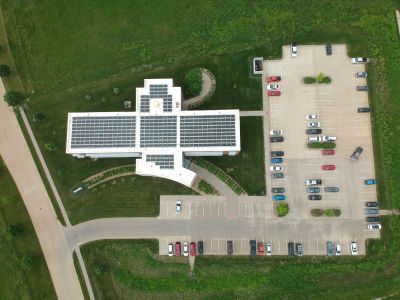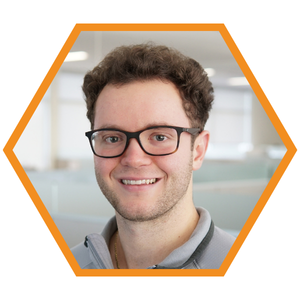Q&A: Design Engineers’ Green Team
Several years ago, Mechanical Engineers Tim Lentz and Darrow Center saw the need for a dedicated space where coworkers could meet, research, and discuss green strategies, share lessons learned, and streamline information for future projects. Fast forward to today, and Design Engineers’ Green Team is a group of passionate colleagues working together to shape the future of sustainable engineering and decarbonization. In this Q&A, Green Team members share more about the group’s goals, initiatives and their own personal reflections on the group’s impact.
What is the main mission of the Green Team?

Darrow Center: While the group doesn’t have a formal mission, we all agree our main purpose is to research and share information on the challenges and opportunities in decarbonization with a 20-to-30-year outlook that encourages balanced decision-making in three main spheres:
- Project Work: As engineers, we’re in a unique position to make a tangible impact on reducing carbon emissions. It’s Design Engineers’ goal to become the Midwest’s employer of choice for engineers passionate about carbon-neutral design. The Green Team helps the whole company advance this goal through researching, documenting, and advancing knowledge of systems, certifications, and awards that promote decarbonization in our work, like geothermal, solar PV, battery storage, electric vehicle or “EV” chargers, Living Building Challenge and Passive House certifications.
- Internal Operations: We want DE to lead by example. Two significant ways the company does this are through our net zero emissions headquarters and free EV charging benefit for employees. Beyond this, the team supports the company’s example by tracking emissions from our buildings, encouraging the use of the company’s EV, reporting the performance of our headquarters’ PV array, maintaining a compost program, and preserving the prairie bioswale surrounding the Cedar Rapid’s office.
- Personal Choices of Employees: We encourage everyone at DE to make sustainable choices in their personal lives. Whether that’s education on composting or taking a reusable coffee cup to work versus a disposable cup, it’s important that our values are reflected in our everyday actions, too!

Why are the team’s efforts focused around a 20-to-30-year timeframe?

Darrow: This timeline is based on a proactive, long-term mindset that considers the science-based goal to achieve net zero emissions by 2050 or sooner and those goals stated by ASHRAE (The American Society of Heating, Refrigeration, and Air Conditioning Engineers). Incorporating a science-based target to guide our group’s work is deeply important to us because this timeline is what is scientifically necessary to avoid the worst impacts of climate change.
What are some of the key initiatives the group has implemented or been working on so far?

Tim: One of our first tasks was updating our company EUI (Energy Usage Intensity) tracking, which is helpful for setting new goals. We measure energy usage from our past projects with EUI, which is a metric that tells us how much energy is used per square foot and allows us to compare projects of different sizes.
Another early effort was creating an Inflation Reduction Act “IRA” summary document. The Inflation Reduction Act of 2022 continues to incentivize building decarbonization, so we centralized information into a single reference document, covering all major topics that impact our industry to help our engineers discuss these opportunities with architects and building owners.

Sam: Some of our more recent efforts include conducting an emissions study where we audited the company’s utility usage and work-related travel over the last 40 years. This audit converted our operations into CO2 equivalents and assessed our Scope 1 or “controlled/organizational owned” and Scope 2 or “indirect” emissions. We looked at strategies that DE has already implemented to reduce emissions, like our net zero office in Cedar Rapids and the use of an all-electric company vehicle. We presented these findings at an all-company meeting to share what’s been done and to propose future strategies.
What strategies does the team use to promote DE’s green projects and initiatives both internally and externally?

Darrow: We encourage everyone at DE to be engaged with these efforts. Internally, we do this by messaging employees about using the company EV instead of personal gas vehicles for work-related travel, and the use of gamification with an EV leaderboard that’s updated monthly to showcase the top employees in EV miles driven! We’re also working on updating our company emissions study each year to share our progress with the team and eventually use this information in external communications to show DE’s commitment and transparency to carbon neutral goals. Beyond that, we review recent projects for award submissions and assist with putting together the applications—an excellent way to share our green efforts with the wider industry!
What are a few of the team’s goals?

Tim: Our primary goal is to create a long-term company plan for decarbonization with clear and measurable targets for 2030 and 2040 that align with the company’s goal of becoming the go-to employer for engineers passionate about carbon neutrality. Another priority is developing a sustainability kick-off process that can be included at the beginning of every project to further empower our clients to reach their sustainability goals and the sustainability goals of their communities. We’re also planning to produce a couple of in-house white papers to inform our engineers about specific sustainable design solutions for different projects!
Why did you decide to join the Green Team?

Allison: DE’s sustainability effort in our projects is one of the most important things we do when it comes to our planet’s future. I’ve always had an interest in sustainability, so when I found out about the Green Team, I thought it would be a great chance to learn more about our sustainability-focused project work.

Pallavi: The things I feel responsible for as a person on this planet is aptly the purpose of the Green Team, so there wasn’t a way I would miss a chance to contribute. The passion of the team ensures me that we are doing the right things!
Can you share a personal story or experience that highlights the importance of the group’s work?

Dalton: One of our group’s tasks is tracking energy reports generated by Willdan. Tracking this information is so important because we’re able to see the impact we’re having on our clients based on the different systems implemented.

Ahmed: My first “EV” miles came through the company vehicle. It’s a great way I can help reduce business-related emissions and I intend to use this resource more often in the future!
What has been the most rewarding part about being involved with the Green Team?

Zarius: I love seeing the collaboration within the team and the creative ideas we have come with to make small, yet significant, changes. It is truly rewarding to see the efforts of a group dedicated to being part of the solution to the greatest problem facing humanity today.

Sam: I enjoy having scheduled time to get together and connect with coworkers about our shared interests for decarbonization and sustainability. In addition to learning from each other about green strategies, a lot of us share the same hobbies involving outdoor activities – hiking, gardening, biking, camping, etc. It’s fun to work with people who you can relate to!
The Green Team is just one example of what sets Design Engineers apart. Discover more stories about our people and the diverse skills and passions they bring to our team.


